RestFramework框架初识
一.前情提要
1.什么是编程
数据结构和算法
2.什么是rest?
(1).传统方式下的url
访问所有数据: 127.0.0.1:8000/books/ 127.0.0.1:8000/get_all_books/ 访问单条数据: 127.0.0.1:8000/books/{id}/ 127.0.0.1:8000/books/{id}?method=get 创建数据: 127.0.0.1:8000/books/add/ 127.0.0.1:8000/books/?type=create 修改数据: 128.0.0.1:8000/books/update/ 删除数据: 128.0.0.1:8000/books/delete/
......
(2).rest下的url
url唯一代表资源,http请求方式来区分用户行为
url的设计规范: GET: 127.0.0.1:8000/books/ # 获取所有数据 GET: 127.0.0.1:8000/books/{id} # 获取单条数据 POST: 127.0.0.1:8000/books/ # 增加数据 DELETE: 127.0.0.1:8000/books/{id} # 删除数据 PUT: 127.0.0.1:8000/books/{id} # 修改数据 数据响应规范: GET: 127.0.0.1:8000/books/ # 返回[{},{},{}] GET: 127.0.0.1:8000/books/{id} # {}单条数据 POST: 127.0.0.1:8000/books/ # {}添加成功的数据 DELETE: 127.0.0.1:8000/books/{id} # ""返回空 PUT: 127.0.0.1:8000/books/{id} # {}更新后完整的数据 错误处理: {"error":"message"}
3.回顾知识点:
(1).CBV: CBV(class base views) 就是在视图里使用类处理请求
urls.py部分:
from django.urls import path from app01 import views urlpatterns = [ path('login/', views.LoginView.as_view()), ]
views.py部分:
from django.shortcuts import render, HttpResponse from django.views import View # Create your views here. class LoginView(View): def get(self, request): return render(request, 'login.html') def post(self, request): return HttpResponse("post")
(2).classmethod & classonlymethod
- classmethod: 修饰符对应的函数不需要实例化,不需要 self 参数,但第一个参数需要是表示自身类的 cls 参数,可以来调用类的属性,类的方法,实例化对象等
class A(object): bar = 1 def func1(self): print ('foo') @classmethod def func2(cls): print ('func2') print (cls.bar) cls().func1() # 调用 foo 方法 A.func2() # 不需要实例化
- classonlymethod: classmethod可以被一个实例调用,但是classonlymethod不能,它只能被类调用( ↓源码解释 )
class classonlymethod(classmethod): def __get__(self, instance, owner): if instance is not None: raise AttributeError("This method is available only on the view class.") return super(classonlymethod, self).__get__(instance, owner)

from django.utils.decorators import classonlymethod class Person(object): def __init__(self, name, age): self.name = name self.age = age def show_info(self): print("show info method been executed") @classmethod def show_info2(cls): print("show info2 method been executed") @classonlymethod def show_info3(cls): print("show info3 method been executed") p1 = Person("pizza", 18) # 普通方法可以通过实例对象和类调用 # 通过实例调用时默认传入self作为第一个参数,不需要手动传入参数 # 通过类调用时,必须手动指定实例对象传递给该方法 p1.show_info() Person.show_info(p1) # 被classmethod装饰器装饰后的方法可以通过实例对象和类直接调用 # 默认传入类名作为第一个参数 p1.show_info2() Person.show_info2() p1.show_info3() # 报错,Django框架实现了classonlymethd,不再允许实例对象调用被该装饰器装饰的方法 Person.show_info3()
(3).getattr, hasattr, setattr
- getattr() 函数用于返回一个对象属性值
>>>class A(object): ... bar = 1 ... >>> a = A() >>> getattr(a, 'bar') # 获取属性 bar 值 1 >>> getattr(a, 'bar2') # 属性 bar2 不存在,触发异常 Traceback (most recent call last): File "<stdin>", line 1, in <module> AttributeError: 'A' object has no attribute 'bar2' >>> getattr(a, 'bar2', 3) # 属性 bar2 不存在,但设置了默认值 3 >>>
- hasattr() 函数用于判断对象是否包含对应的属性。
class Coordinate: x = 10 y = -5 z = 0 point1 = Coordinate() print(hasattr(point1, 'x')) print(hasattr(point1, 'y')) print(hasattr(point1, 'z')) print(hasattr(point1, 'no')) # 没有该属性
- setattr() 函数对应函数 getattr(),用于设置属性值,该属性必须存在
>>>class A(object): ... bar = 1 ... >>> a = A() >>> getattr(a, 'bar') # 获取属性 bar 值 1 >>> setattr(a, 'bar', 5) # 设置属性 bar 值 >>> a.bar 5

class Person(object): def __init__(self, name, age): self.name = name self.age = age self._hobby = 'girls' def show_info(self): print("show info method been executed") p1 = Person("pizza", 18) # 查看该对象是否有show_info方法 print(hasattr(p1, "show_info")) # 查看该对象是否有age属性 print(hasattr(p1, "age")) print(hasattr(p1, "hahaha")) greeting = "Hello World" # 设置属性 setattr(p1, "hahaha", greeting) print(hasattr(p1, "hahaha")) func = getattr(p1, "show_info") print(func) # <bound method Person.show_info of <__main__.Person object at 0x102219d68>> # 注意:直接调用,不需要传入self,getattr时已经绑定self到func了 func() print(hasattr(Person, "show_info")) # True print(hasattr(Person, "name")) # False print(hasattr(Person, "country")) # False # 给Person类设置属性 setattr(Person, "country", "china") print(hasattr(Person, "country")) # True print(hasattr(p1, "country")) # True
(4).self定位
始终指向调用者

class Request(object): def show_request(self): print(self) class NewRequest(Request): def show_request(self): print(self) request = NewRequest() # 调用方法的实例对象是哪个,self就指向哪个对象 request.show_request()
(5).http请求协议
沟通双方约定俗成的规范,解析数据的规则
Http请求报文包含三部分: 分别是请求行, 请求报文头, 请求报文体
POST /classbasedview/login/ HTTP/1.1 Host: 127.0.0.1:8000 Connection: keep-alive Content-Length: 110 Cache-Control: max-age=0 Origin: http://127.0.0.1:8000 Upgrade-Insecure-Requests: 1 Content-Type: application/x-www-form-urlencoded User-Agent: Mozilla/5.0 (Windows NT 10.0; Win64; x64) AppleWebKit/537.36 (KHTML, like Gecko) Chrome/70.0.3538.102 Safari/537.36 Accept: text/html,application/xhtml+xml,application/xml;q=0.9,image/webp,image/apng,*/*;q=0.8 Referer: http://127.0.0.1:8000/classbasedview/login/ Accept-Encoding: gzip, deflate, br Accept-Language: zh-CN,zh;q=0.9 Cookie: csrftoken=JHQb0vR5sgT2FF1UCrznIkJyPkucrHso5Tf0K9tEnc1kS1LZ16TIB9mx2LNxuivY
注意: POST请求类型有formdata, 而get没有!

POST /classbasedview/login/ HTTP/1.1: 第一行表示请求行,分别是请求方式(POST),请求URL,HTTP协议版本 HOST: 请求行下面的都是请求报文, HOST表示请求的主机和端口号 Connection: 请求连接方式 Content-Length: 内容长度(字节) Content-Type: 请求数据的编码协议,只有POST,DELETE等请求方式该部分内容(须重点记忆) User-Agent: 客户端信息 Accept: 可接受的响应内容类型 Accept-Encoding: 采用什么方式对请求数据进行编码 Cookie: 服务端设置的cookie

csrfmiddlewaretoken=DScaV6Yxya9TiYychh4he3SapDbldYkkZ4BZFKA6t6hbvkihGWoC7Sv9C4uGgznU&user=zm&password=123
(6).form enctype
application/x-www-form-urlencoded multipart/form-data text/plain
(7).JavaScript object {name:"wahaha"} ==> json的转换方式
JSON.stringify(data) ==> python json.dumps()
JSON.parse(data) ===> python json.loads()
二.Django restframework
1.开始使用DRF
(1).DRF安装:
DRF官方文档中有详细介绍. 使用↓命令安装,首先安装Django,然后安装DRF
>>> pip install django
>>> pip install djangorestframework
1.APIView 2.解析器组件 3.序列化组件 4.认证组件 5.权限组件 6.频率组件 7.url控制器组件 8.分页器组件 9.响应器组件
2.回顾Django View请求流程
(1).分析一下Django中的views.View类的源码, 请看下图:
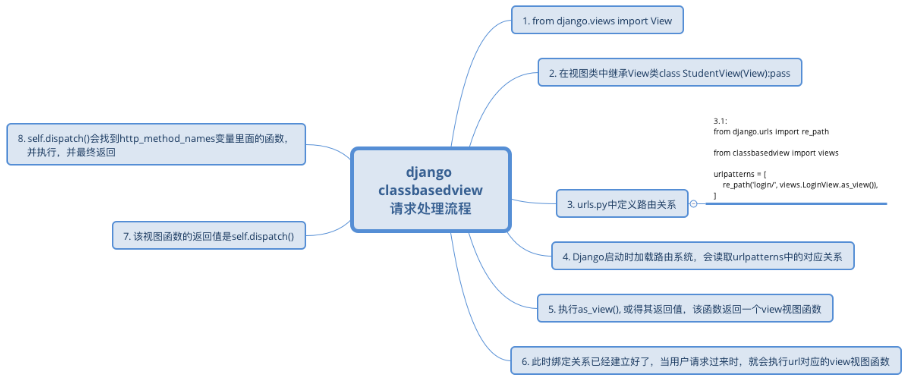
3.Django RestFramework的APIView是如何对Django框架的View进行功能扩展的
from django.shortcuts import HttpResponse import json from .models import Courses # 引入APIView from rest_framework.views import APIView # Create your views here. class CoursesView(APIView): # 继承APIView而不是原来的View def get(self, request): courses = list() for item in Courses.objects.all(): course = { "title": item.title, "description": item.description } courses.append(course) return HttpResponse(json.dumps(courses, ensure_ascii=False))
(1).DRF APIView请求流程源码:
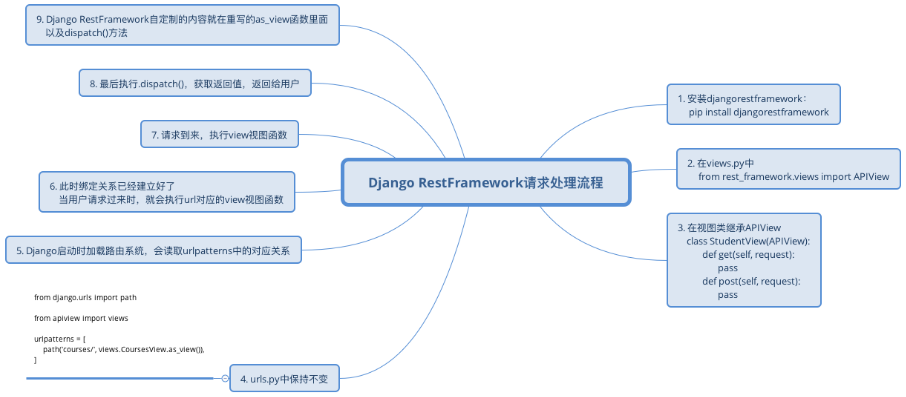
(2).Ajax发送JSON数据给服务器
<!DOCTYPE html> <html lang="en"> <head> <meta charset="UTF-8"> <title>Title</title> <script src="https://cdn.bootcss.com/jquery/3.3.1/jquery.min.js"></script> <script src="/static/jquery-1.10.2.min.js"></script> </head> <body> <form action="" method="post" enctype="application/x-www-form-urlencoded"> {% csrf_token %} 用户名: <input type="text" name="username"/> 密码: <input type="password" name="password"/> 提交: <input type="submit" value="提交"/> </form> <hr> <button class="btn">点击发送Ajax请求</button> <script> $(".btn").click(function () { $.ajax({ url: '', type: 'post', contentType: 'application/json', data: JSON.stringify({ username: "hehe", password: 123 } ), success: function (data) { console.log(data); } }) }) </script> </body> </html>
通过如上代码已知,Content-Type用来定义发送数据的编码协议, 所以,在上面的代码中,我们指定Content-Type为application/json,即可将我们的Json数据发送到后端
4.postman工具介绍
安装POSTMAN,官网下载安装
(1).发送get请求
请看下面的图片:
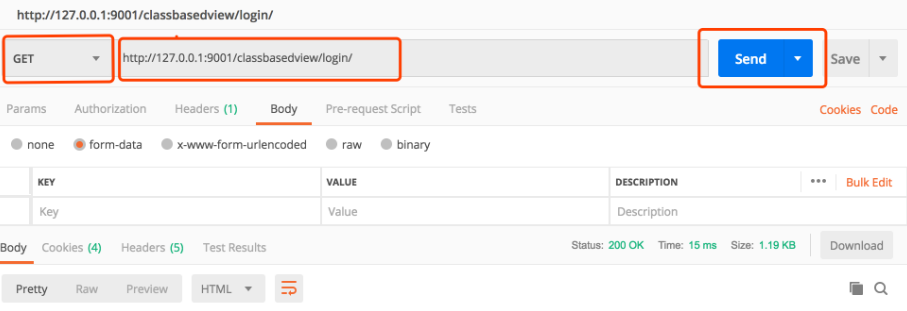
如图所示,在下拉框中选择GET方式发送请求,在地址栏输入请求url,然后点击send发送即可发送GET请求到后端服务器。
(2).以urlencoded协议发送post请求
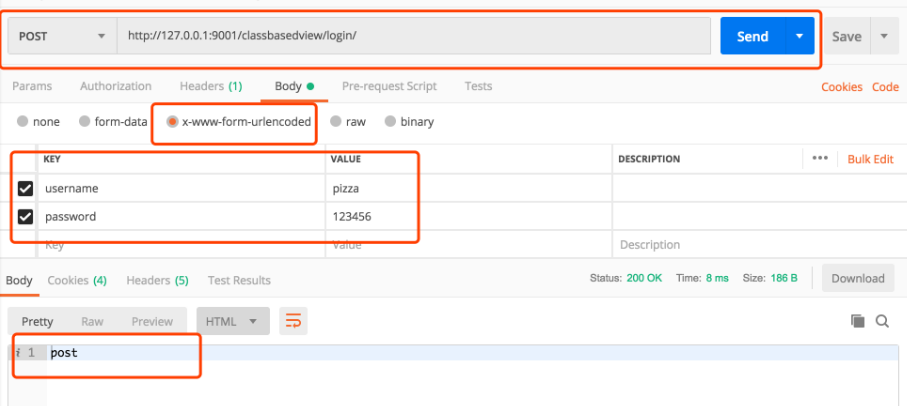
选择POST,输入地址,然后在下面的选项框中选择Body,之后选择x-www-form-urlencoded协议,输入key和value,点击Send,即可以urlencoded方式发送post请求,并且在最下面的提示框中可以查看到服务器返回的信息
(3).以JSON协议发送POST请求
最后,请看下图,以Json协议发送POST请求:
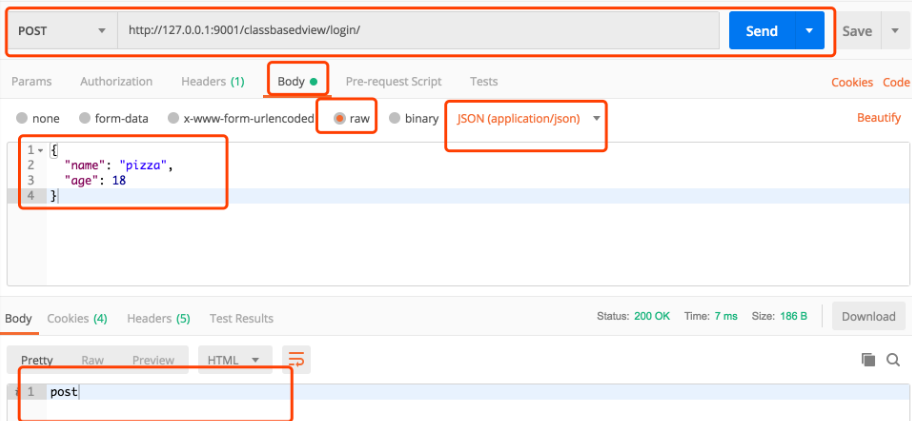
前面都一致,在Body框中,选择raw选项,然后选择application/json,最后输入Json格式的数据,点击Send即可以Json协议发送POST请求。
4.Django Rest Framework -APIView源码分析
(1).as_view()
先从URLconfig中入手,由于BookView是一个基于类的视图,所以我们将URL指向as_view()类方法
path(r'books/',views.BookView.as_view()),
此时,我们的BookView以经不是继承自Django.views中的View了,而是restframework.views中的APIView
(2).安装Django RestFramework
pip install djangorestframework
(3).BookView视图类:
from django.shortcuts import render,HttpResponse #导入APIView from rest_framework.views import APIView #继承自APIView class BookView(APIView): def get(self,request): return HttpResponse('get....') def post(self,request): return HttpResponse('post....')
(4).as_view():由于BookView没有实现as_view()方法,Django启动时,调用as_view()是APIView中的as_view()
@classmethod def as_view(cls, **initkwargs): """ 将原始类存储在视图函数上 这允许我们在执行url反向查找时发现有关视图的信息。 """ ... #由于APIView是继承自django.views中的View(上篇博客接触过) #调用父类(View)中的as_view() view = super(APIView, cls).as_view(**initkwargs) view.cls = cls view.initkwargs = initkwargs # 提示: 基于会话的身份验证被明确地CSRF验证 # 所有其他身份验证都免予使用CSRF。 # 跳过CSRF验证 return csrf_exempt(view)
在APIView中的as_view()方法什么都没做,只是调用了父类的as_view()方法; as_view()方法会返回self.dispatch(),由于BookView没有实现这个方法,所以我们查看APIView中dispatch()都做了哪些工作
(5).dispatch():和Django.view中View类的dispatch()派遣相同,额外添加了一些功能
# Note: 在“派遣”需要被改写的情况下,可以在"as_view"范围内对CSRF进行豁免,以防止意外移除这一豁免。 def dispatch(self, request, *args, **kwargs): """ 和django.views中View的dispatch()调度差不多, 但是有额外的钩子用于启动、终结和异常处理。 """ self.args = args self.kwargs = kwargs request = self.initialize_request(request, *args, **kwargs) self.request = request self.headers = self.default_response_headers # deprecate? try: self.initial(request, *args, **kwargs) # 获取适当的程序处理方法,这里的调度和django View的调度一样 if request.method.lower() in self.http_method_names: handler = getattr(self, request.method.lower(), self.http_method_not_allowed) else: handler = self.http_method_not_allowed # 调用HTTP请求处理方法,并返回 response = handler(request, *args, **kwargs) except Exception as exc: response = self.handle_exception(exc) self.response = self.finalize_response(request, response, *args, **kwargs) return self.response
APIView中的dispatch()和Django中的dispatch()类似,不同之处,APIView对request请求对象进行了重新封装
(6).request:APIView和request对象进行了重新封装
def dispatch(self, request, *args, **kwargs): """ `.dispatch()` is pretty much the same as Django's regular dispatch, but with extra hooks for startup, finalize, and exception handling. """ self.args = args self.kwargs = kwargs request = self.initialize_request(request, *args, **kwargs) self.request = request self.headers = self.default_response_headers # deprecate? ....
默认的是django.core.handlers.wsgi.WSGIRequest对象,通过调用initialize_request()将其封装成rest_framework.request.Request, 通过type(request)来查看
(7).initialize_request(): 做了哪些工作
def initialize_request(self, request, *args, **kwargs): parser_context = self.get_parser_context(request) # 返回了一个reuqest请求对象 return Request( request, parsers=self.get_parsers(), authenticators=self.get_authenticators(), negotiator=self.get_content_negotiator(), parser_context=parser_context )
Request类: 完善request请求的一些注意事项 ,例如用户登录,检测权限等
class Request(object): def __init__(self, request, parsers=None, authenticators=None, negotiator=None, parser_context=None): ... #将原始的WSGIReqeust对象复制给_request self._request = request .... #调用旧的request.GET @property def query_params(self):return self._request.GET #调用旧的request.POST @property def POST(self):return QueryDict('', encoding=self._request._encoding)
之后使用的request,都是restfromwork封装的Reqeust对象
2.APIView的使用
from res_framework.views import APIView class LoginView(APIView): def get(self, request): pass




 浙公网安备 33010602011771号
浙公网安备 33010602011771号